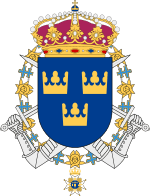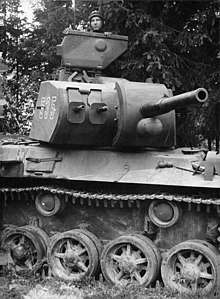Göta Armoured Life Guards' Company in Gotland
Göta Armoured Life Guards' Company in Gotland (Swedish: Göta pansarlivgardes kompani på Gotland or P 1 Gotland), designated P 1 G, was a Swedish Army armoured unit that was active in various forms 1944–1963. The unit was based in Visby Garrison in Visby, Gotland. It was part of Göta Armour Guards Regiment until 1963.[2][3]
| Göta Armoured Life Guards' Company in Gotland | |
|---|---|
| Göta pansarlivgardes kompani på Gotland | |
 | |
| Active | 1944–1963 |
| Country | |
| Allegiance | Swedish Armed Forces |
| Branch | Swedish Army |
| Type | Armoured |
| Size | Company |
| Part of | Göta Armour Guards Regiment |
| Garrison/HQ | Visby |
| Colors | Red |
| March | "Göta livgardes marsch" (Schubert)[note 1] |
| Battle honours | Svensksund (1790) |
History

The unit was raised in 1944 as a detachment on Gotland of the Göta Armour Guards Regiment (P 1). The detachment mainly consisted of a heavy tank company, which had been added from the 10th Armored Brigade. Initially, the company was armed with 18 Stridsvagn m/42, which were replaced in September by 20 Stridsvagn m/41. On 30 March 1963, the detachment was disbanded. On 1 April 1963, the unit was amalgamated with the Gotland Infantry Regiment (I 18) and formed Gotland Regiment (P 18).[2][3]
Barracks and training areas
Barracks
On 1 October 1944, the company was placed to Gotland. The detachment was placed in barracks at Gotland Infantry Regiment (I 18). From 1946, the detachment moved into a newly built barracks, Barracks IV (known from the 1960s as barracks Havde), at Gotland Infantry Regiment.[3]
Training areas
The detachment on Gotland conducted its training at Hällarna in Visby and at the Tofta proving ground.[3]
Heraldry and traditions
Colours, standards and guidons
The unit received its colour on 6 June 1947. It was presented by the military commander of the VII Military Area, major general Samuel Åkerhielm at a ceremony at Oscarsstanen, at which both I 18, A 7, P 1 G and Lv 3 G participated. P 1 G's colour was taken down on 31 March 1963, the last day P 1 G existed as an independent unit. The colour was then put away for 25 years. Colonel Stig Barke, the commanding officer of P 18 from 1983 to 1988, thought that P 18 would manage the memory of P 1 G with the colour as the basis. When P 18 on 30 March 1988 celebrated its 25 years as an armoured regiment, the colour was shown once again. It was handed over to major Anders Österberg, commander of the tank company, by the last commanding officer of P 1 G, the retired lieutenant colonel Bo Forsman. The colour then came to be carried in parallel with the regiment's own colour until the spring of 2000, when it was taken down for the last time, because the tank training at P 18 then ceased.[4]
Commanding officers
List of commanding officers of the detachment from 1944 to 1963.[5]
- 1944-04-01 – 1945-09-30: CPT Rolf von Krusenstierna
- 1945-10-01 – 1949-05-20: CPT Bengt Ewertz
- 1949-05-21 – 1953-08-31: CPT Sten Sundblad
- 1953-09-01 – 1955-09-30: CPT Gustaf Follin
- 1955-10-01 – 1959-03-31: CPT Gunnar Lagerström
- 1959-04-01 – 1963-03-31: CPT Bo Forsman
Names, designations and locations
| Name | Translation | From | To | |
|---|---|---|---|---|
| Göta pansarlivgardes kompani på Gotland | Göta Armoured Life Guards'[6] Company in Gotland | 1944-10-01 | – | 1963-03-31 |
| Designation | From | To | ||
| P 1 G | 1944-10-01 | – | 1963-03-31 | |
| Location | From | To | ||
| Visby Garrison | 1944-10-01 | – | 1963-03-31 |
See also
Footnotes
- The company shared the march with the Göta Armour Guards Regiment.[1]
References
Notes
- Sandberg 2007, p. 69
- Braunstein 2003, pp. 149–152
- Holmberg 1993, p. 24
- Olsson, Kjell. "Gotländska militära fanor 1887-2005". www.tjelvar.se (in Swedish). Gotlands försvarshistoria & Gotlands trupper. Retrieved 29 January 2019.
- Hammarhjelm 1999, pp. 253
- Gullberg 1977, p. 630
Print
- Braunstein, Christian (2003). Sveriges arméförband under 1900-talet. Skrift / Statens försvarshistoriska museer, 1101-7023 ; 5 (in Swedish). Stockholm: Statens försvarshistoriska museer. ISBN 91-971584-4-5. SELIBR 8902928.CS1 maint: ref=harv (link)
- Gullberg, Ingvar E. (1977). Svensk-engelsk fackordbok för näringsliv, förvaltning, undervisning och forskning [A Swedish-English dictionary of technical terms used in business, industry, administration, education and research] (in Swedish) (2nd ed.). Stockholm: Norstedt. ISBN 91-1-775052-0. SELIBR 8345587.CS1 maint: ref=harv (link)
- Hammarhjelm, Bengt (1999). Beredskap på Gotland 175 år: 1811-1986 (in Swedish) (2nd, extension, and supplement to 2000 ed.). Visby: Ödin. ISBN 91-85716-84-7. SELIBR 7751982.CS1 maint: ref=harv (link)
- Holmberg, Björn (1993). Arméns regementen, skolor och staber: [en uppslagsbok] : en sammanställning (in Swedish). Arvidsjaur: Svenskt militärhistoriskt bibliotek (SMB). ISBN 91-972209-0-6. SELIBR 7796532.CS1 maint: ref=harv (link)
- Sandberg, Bo (2007). Försvarets marscher och signaler förr och nu: marscher antagna av svenska militära förband, skolor och staber samt igenkännings-, tjänstgörings- och exercissignaler (in Swedish) (New ed.). Stockholm: Militärmusiksamfundet med Svenskt marscharkiv. ISBN 978-91-631-8699-8. SELIBR 10413065.CS1 maint: ref=harv (link)